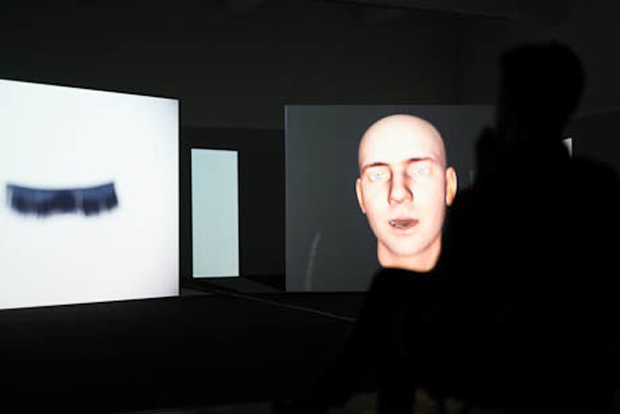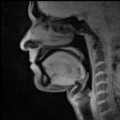You have no items in your cart. Want to get some nice things?
Go shopping
When walking into the space at the Chisenhale Gallery I was confronted with a wave of spatial awkwardness. I wanted the familiarity of that easy cinema construct: the seating and the screens. Ed Atkins doesn’t offer this. Instead the seating is in the middle of the space, with collaged panels lining the walls around. I remained in the middle of an art space rather than being in front of a screen, and as people floated around me I felt the sharp, uncomfortable pang of inhabiting a space ordered by light and resonance rather than traditional grids with fronts and backs.
Us Dead Talk Love is not ‘screened’ in this space. Rather, the spatial formatting of Us Dead Talk Love is cinema deconstructed, thereby this piece operates as an installation, but one that betrays the sensitivities and conventions of this genre. Consisting of two high-definition format 16:9 videos projected onto 4:3 screens, the light runs past these screens and floods out into the corners of the gallery space “like parentheses”, as Atkins described them during an interview with Katie Guggenheim at the gallery as part of this show. Such an enveloping platform for the film(s) bolsters the poignant questions present in his work—of the relationship between media, corporeality, presence and representation—which are also explored through his coagulation of digital and corporeal tangibility, in A Tumour, presented at Tate Britain for “Art Now” in 2011.
Exploring the contemporary materiality of digital ‘film’, animation and sound is a great focus of Atkins’ practice. The unique ‘fleshing’ out of age-old ontological questions by way of current technologies is a practice that is arguably more important today than twenty years ago, precisely because the materiality of technology, data and content is so uncertain, as Atkins also commented on in interview:
. . . in spite of the continued dissimulation of the material of moving image, we must still look for it, and one of the places that one might try to find this material aspect of the digital would be inside the viewer, where it would reterritorialise and become manifest.
The dialogue in Us Dead Talk Love approaches these ideas as much as the medium and execution of the piece. Two animated digital cadavers soliloquise alternately upon the metaphysical implications of finding an eyelash behind their foreskin. Whilst listening to these meandering meditations upon a rogue eyelash I recalled two major thinkers of the 20th century: George Bataille and Jacques Derrida. I’d be surprised if Atkins is not familiar with both. Amongst the imagery of eyes, eyelashes, intimacy, loss and death the conceptual framework and narrative of this piece open up a vista of hidden forces, meanings and connections. As the relationship between the mind’s eye of the viewer and the video matter are smudged and doubted, calling into question the materiality of the work, there appears the ominous looming of a potentiality not dissimilar to aspects of Base Materialism—a concept Bataille had developed in the late 1920s and early 30s in an attempt to challenge existing ideas of materialism. As the meaning of the eyelash, chance, and the possible relationship between the two, were relentlessly probed and destabilized by the cadavers’ meditations, I couldn’t help but feel the force of limitless possibilities looming with uncertainty.
Around the gallery an eyelash is collaged on to boards, a single mark, a painterly black absence ripped into the white. This theme of absence was also present in the narrative. Upon engagement with the breathy, honest outpourings coming from the six speaker channels, the listener/viewer is privy to an intimate stream of thoughts concerning death, life, materiality and representation. In these passages the eyelash is the mark of a loss—an absence signifying a past presence. Yet hair is also the only part of adults that continues to grow despite being dead itself (paradoxically the eyelash is spoken of by the cadavers as both life and death at different stages in the piece). The influence of Derrida in this work was to the point of being literal: the solitary black line and the eyelash against skin almost a corporeal iteration of Derridean thought, which takes the Möbius strip of presence and absence, truth and signified for its central themes.
These musings, the paradoxes and emerging metaphors that contemplate life or death, skin and hair in representation, are sublime. However, strikingly, the real poignancy of these questions is in their liminal emergence. Whilst viewing the eloquent, virtual cadavers ‘your’ mind wanders amidst the materialities of the piece: its research, construction, creation and the narrative in the air. I found that my slipping and shifting thoughts validated Atkins’ questions by fact of their very fleeting nature. For example, one moment I was transported away to a lint-flecked duvet bathed in the cold morning air, I felt the privilege of this intimate insight, before my thoughts rushed back to the glowing screen before me. I then questioned if the skin rendering on the head in this moving image was unrealistic, or just too real. In the indefinite space between the temporality of narrative and materiality of installation, I sensed the profundity of Atkins’ exploration around the tragedy of life, death and representation.
When Atkins refers during his interview to the “material aspect of the digital” this should be interpreted in the widest possible sense. The materiality of the work is explored in at least three ways. Firstly in the spatial overspill of digital formats and sub-bass effects that affect the viewer; the materiality of digital film is physically spilling around the space, off the screen and speakers and into the dark corners and cold air of the gallery. Secondly by the rendering of skin in the animation of the cadavers’ jaws and the visceral presence of the voice, there is an accomplished virtual materiality that constantly confronts and seduces the viewer. Thirdly in the narrative, incorporating the history of hair, the recollection of events, and the speculations over the origin of the eyelashes, a diegesis afforded by succumbing to the story of the ‘real’ speaker—in believing digital apparitions to be true. Atkins’ work explores each of these, but Us Dead Talk Love is not merely a ‘cinematic’ installation exploring the ‘uncanny valley’. Although it does explore this to some degree, uniquely it does so whilst simultaneously engaging with an ontological question of subjectivity and objectivity from within the liminal degrees of slippage. The profundity of Us Dead Talk Love is that permeating these degrees of unreal, real and Hyperreal is the ever-present paradox of the sheer visceral and the utterly digital.
Us Dead Talk Love runs until 11 November at the Chisenhale Gallery, London. More of Ed Atkins’ work at edatkins.co.uk.

About Tristam Vivian Adams
Tristam Vivian Adams is currently studying at Goldsmiths College. He blogs at notesfromthevomitorium.blogspot.co.uk.




